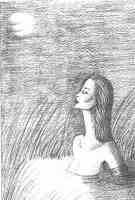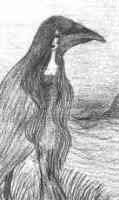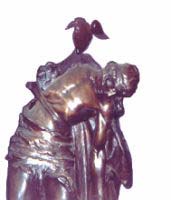The feminine in early Irish myth and legend
In early Irish mythology and legend, the feminine is quite dominant in the otherworld as well as on earth. The land of Ireland and features of its landscape such as mountains, rivers and lakes were frequently associated with goddesses and other supernatural females.
Early Irish deities did not have specialised areas of influence like those of the Greeks and Romans, for instance. The same Irish goddess could be a young woman or a hag, a mother or a virgin, a warrior or a seductive temptress, depending on the occasion.
- In mythology, it was Ériu who gave her name to Ireland but the names of her two sister goddesses Banba and Fodla were also used.
- Another trio of sister goddesses were all called Brigid and they were patrons of fertility, healing, smiths and poetry. They presided over a perpetual fire and the spring festival of Imbolc.
- Anu was an important goddess of pre-Christian Ireland and gave her name to two breast-shaped hills in Kerry called the 'Paps of Anu.' She may be identical to Dana after whom the Tuatha de Danann are called.
- Emhain Macha (now called Navan Fort) near Armagh, was named for Macha who, according to legend, was forced while pregnant to race against the king's horses to save her husband from shame and dishonour. She won the race, gave birth to twins immediately and died cursing the men of Ulster to suffer the pains of childbirth at times of greatest difficulty.
- The Béara Peninsula was the home of the sovereignty figure, Cailleach Bhéirre or Hag of Béara, known from a famous ancient poem 'Sine mé ná an Chailleach Bhéirre, …'
- The Hill of Tara commemorates the name of a queen called Téa; Knockshegowna Hill commemorates Úna, a fairy queen and Knockaney Hill commemorates another fairy queen Áine.
- How the rivers Shannon, Boyne and Liffey were named after the females Sinann, Bóann and Life gave rise to fascinating stories of origin.
- Legend had it that Cessair, grand-daughter of Noah, was the first person ever to set foot in Ireland.
|

River goddess
Tríona de Bairéid
|
Goddesses symbolised the land. As ancient as the landscape, they were imagined as being restored to youth and fertility when united with a succession of their mates, the kings. The inauguration of the king of a tuath was called a 'banaisrighe' or 'wedding of the king.' He 'married' the land, represented by a white mare, sacred to the goddess. Females, however, could not be sovereigns, though they embodied or symbolised sovereignty.
Legends depict supernatural women enticing mortals to the otherworld. Niamh lured Oisín to Tír na nÓg, Clíona enticed Tadg to a similar happy haven and Bran was drawn by magical music and visions to the Land of Women.
The most spectacular supernatural women were those associated with war and death, especially the Badbh, Macha and the Morrigan, a trio of female personifications of terror and rage. In the literature they scream in the air causing panic to men in battle.
As 'shape-shifters' they could appear as young or old women seducing men or as crows or animals hovering around the battle field to gloat over the sufferings of warriors and pounce on their bodies when dead.
Because Cúchulain refused the favours of the Morrigan in the shape of a young woman, she vowed to take revenge and 'shape-shifted' to an eel winding about his legs to trip him in battle and to a wolf that stampeded a herd of cattle at him. She later landed on his dead body in the shape of a raven.
|

The Morrigan could
shape-shift to a raven.
Tríona de Bairéid |

The death of Cúchulain
As represented in 1935 for GPO,
Dublin by Oliver Sheppard
|
The 'washer at the ford' was an omen of death for those who saw her washing bloody garments at the ford of a river. She finds an echo in the banshee of Irish folklore who is also said to give warning of approaching death.
Women were depicted as teaching warriors the arts of war and some went to war themselves. Scáthach and her rival Aífe, both women-warriors in Scotland, instructed Cúchulain in fighting skills. It was Scáthach who presented him with his magic sword, the gae bolga, while Aífe was the mother of his son, Connla, whom Cúchulain killed with the gae bolga, not recognising him in time as his son. Ness, mother of high king Conchobar Mac Nessa, who was called after her, was a champion fighter and the great epic Táin Bó Cuailgne tells the story of Medb of Connacht who led her army in pursuit of the Brown Bull of Cooley.
In several well-known love stories of Irish legend, women invite attractive men to elope and if refused, put them under a spell or geis to obey them.
- The ageing king Conchobar Mac Nessa wanted to reserve the beautiful young Deirdre for himself but on meeting Noisiu, she 'caught the two ears of his head' and forced him to go away with her, with tragic consequences for himself and his brothers Ardan and Ainnle.
- Diarmuid Ó Duibhne tried to keep his magic ball seirce, the love spot on his forehead hidden from women but Gráinne looked on it and was seized with an irresistible passion. At her marriage to the elderly Fionn mac Cumhaill she placed Diarmuid faoi gheasa (under a spell) to elope with her. They wandered all over Ireland, sleeping on dolmens, 'beds of Diarmuid and Gráinne', pursued by the angry Fionn.
- Oisín, son of Fionn was enticed by the beautiful Niamh Chinn Óir to Tír na nÓg, the land of the ever-young. There they lived happily for three hundred years until Oisín, lonely for his father's band of Fianna, got permission to return to Ireland on a white horse. He discovered that the Fianna were long dead and the land completely changed. The magic spell of everlasting youth was broken when the reins of his horse broke as he was trying to help Wicklow men lift a large stone. Falling to the ground, he 'came back down to earth', turned into a very elderly man and the white horse flew back to Tír na nÓg without him.
Did these mythical and legendary women and men share qualities with the living women and men of the time? Were they admired? Were they seen as role models? Or were they seen as 'foolish and excessive' as some modern scholars think? What do stories tell us about the cultures that listen to them? Do popular stories, without other evidence, necessarily reflect the character of a culture?
There is little evidence that the divine and human worlds are reflections of the other in terms of gender … The religious life of Athens in the fifth century BC was focused on the all-important … goddess Athene, yet Athenian women … did not even enjoy citizenship. We can see how, in our own day, the leadership of Margaret Thatcher for more than a decade has done little for the status of women in Britain.
Miranda Greene, Celtic goddesses, London, 1997, p. 15. |
However, the lively characters, plots and atmosphere of early Irish myth and legend have enlightened and entertained people down through the ages. Surprisingly undeterred by astonishing pagan activities, monks in early Christian monasteries preserved these aspects of early Irish culture.
| A list of types of early Irish stories gives us some idea of their number and scope: |
| Destructions |
Adventures |
Loves |
Sieges |
| Cattle-raids |
Elopements |
Expeditions |
Conceptions and births |
| Courtships |
Slaughters |
Invasions |
Frenzies |
| Battles |
Irruptions |
Caves |
|
| Feasts |
Visions |
Violent deaths |
|
| Alwyn & Brinley Rees, Celtic Heritage, London, 1961, p. 208. |
A continuous chain of story telling down through the years preserved many of these stories in rural folklore, often with interesting variations. Ireland has one of the best folklore collections anywhere, partly because an immense amount was recorded through the national schools in the 1930s by the Irish Folklore Commission and placed in an archive in Dublin where it is available to researchers.
Questions
- What is meant by any four of the following terms used in the above text? banaisrighe, shape-shifter, washer-at-the-ford, banshee, gae bolga, ball seirce, geis.
- Name three important features of an early Irish goddess.
- Identify four shapes taken by the Morrigan.
Activities
- Research an Irish personal name or surname and briefly tell the story behind it.
- Research any place name in Ireland which has a myth of origin and briefly tell the story .
- Briefly relate your favourite Irish myth or legend.
- Role play the Morrigan.
- Role play a scene where someone is placed faoi gheasa (under a spell).
- Draw or paint any scene in the above section or any scene from Irish mythology.
- Write a poem about any scene in the above section or any scene from Irish mythology.
- Do a project on any aspect of women in Irish mythology.
- Research a few differences between Irish mythology and any other mythology.
- Interview a person who has preserved folklore and record at least one story.
- Research the folklore collected in your own area in the 1930s.
- Select any one of the following aspects of twentieth century culture and pretend to be a historian in the year 3500 AD discussing our culture:
science fiction; thrillers; horror movies; cartoons; pornography; computer games; soaps; women's magazines; tabloid newspapers; sports pages.


